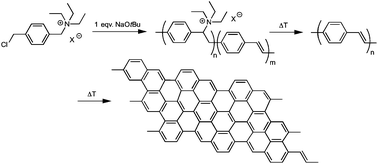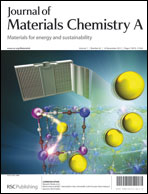A new carbon precursor: synthesis and carbonization of triethylammonium-based poly(p-phenylenevinylene) (PPV) progenitors†
Abstract
Unsubstituted poly(p-phenylene vinylene) (PPV), when heated under an inert atmosphere, has very high char yields at temperatures up to 1800 °C and is a potential source of carbonaceous material. However, using unsubstituted PPVs in the synthesis of carbon materials is hindered by their limited processability into fibers or free-standing films before carbonization. To circumvent processability problems, the synthesis of soluble ammonium-based PPV precursors was accomplished, and the first ammonium-based PPV films were carbonized. 1-(Chloromethyl)-4-[(triethylammonium)methyl]benzene chloride was polymerized via an analogous approach to the Gilch reaction under basic conditions. Significant elimination of ammonium groups occurred during polymerization, but the 5–20% remaining ammonium functionalities allowed for solubility in polar aprotic solvents such as dimethylsulfoxide (DMSO). A post-polymerization exchange of the ammonium functionality to a larger counter anion, p-toluenesulfonate, provided more flexible, film-forming PPV-based polymers. Additionally, the low fraction of ammonium groups on the backbone facilitated a low weight loss during carbonization, up to 51 wt% remaining at carbonizations up to 1800 °C, and preservation of the final film structure. These films were carbonized at temperatures of 1000, 1400, and 1800 °C and were analyzed with scanning electron microscopy, Raman, Fourier-transformation infrared spectroscopy, X-ray diffraction, and conductivity measurements to examine the development of the carbon structure.


 Please wait while we load your content...
Please wait while we load your content...